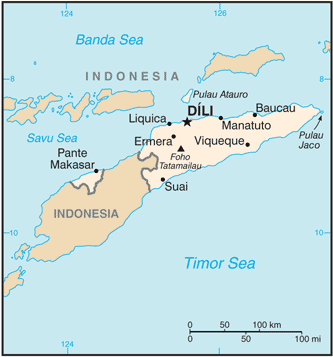Covert efforts against East Timor, including engineering a break between two political parties, failed and the Indonesian army, convinced that no international powers would object, invaded East Timor. The invasion targeted civilians and included mass public executions. Fretilin became the main source of organized resistance in mountain strongholds in the country’s interior, while Indonesian forces occupied most of the country. Many people fled to Fretilin-controlled areas to escape the violence. Fretilin was unable to provide adequate resources to support these refugees, especially under continued Indonesian attacks. Those who returned to Indonesian-occupied areas, however, were forced into resettlement camps which often did not provide for basic needs.
The Indonesian occupation was brutal and aimed to terrorize the population into submission. Fretilin supporters and their families were murdered and entire villages destroyed. Imprisonment and torture were common. Conditions improved marginally once international agencies were able to reach the population, but East Timorese faced continuing discrimination and terror while indonesian migrants dominated economic and political power. This occupation involved an estimated 170,000 deaths, about 25% of the 1975 population, between 1975 and 1999.
The occupation came to the world’s attention after the massacre of 270 civilians protesting at the Santa Cruz cemetery in Dili, the capital, was caught on video in 1991. When the Indonesian military dictatorship fell, Indonesia’s new leader called a referendum on East Timorese independence in 1999. The Indonesian army understood that there was strong support for independence, which threatened their economic interests. In an attempt to terrorize the populace to vote against independence, the army unleashed local paramilitary forces known as ninjas to murder hundreds of people. Despite this effort, 78.5% of East Timorese voted for independence, setting off another round of massacres. Protests around the world convinced foreign governments, including the United States, to withdraw military aid to Indonesia. Faced with concerted international pressure, Indonesia relinquished control of East Timor to an international force, and East Timor became an independent state.
Despite its independence, East Timor still shares its island with Indonesia. Chronic underdevelopment from years of occupation has left the country poor and traumatized. Despite the existence of the UN-sponsored Commission for Reception, Truth and Reconciliation and a Commission of Truth and Friendship set up between Timor-Leste and Indonesia, most perpetrators have never been tried. Timor-Leste is now trying to build up state institutions despite being one of the poorest countries in the world.
Sources:
Dunn, James. “Genocide in East Timor.” In Centuries of Genocide: Essays and Eyewitness Accounts, edited by Samuel Totten and William S. Parsons. 4th ed. New York: Routledge, 2013.
Jones, Adam. Genocide: A Comprehensive Introduction. 3rd ed. London: Routledge, 2017.

CIA World Factbook: https://www.cia.gov/library/publications/the-world-factbook/geos/tt.html